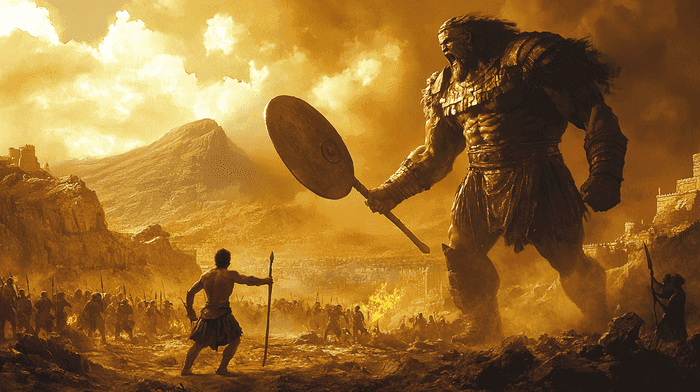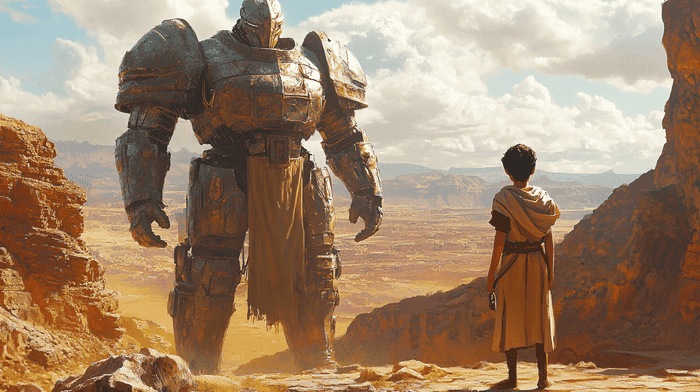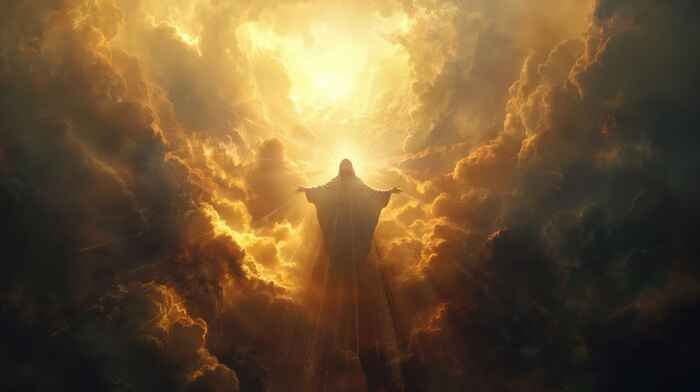The Battlefield: Setting the Stage in the Valley of Elah
The Valley of Elah, a wide stretch of land with hills rising on both sides. On one hill, you’ve got the Israelites, camped out and holding their breath. On the other, the Philistines, loud and ready for a fight. And in the valley between them stands Goliath: towering, armed to the teeth, and calling out a challenge that’s been echoing for days.
The Philistines were Israel’s long-time enemies, and Goliath was their champion. The Bible describes him as “six cubits and a span” tall (that’s around nine feet, though some ancient texts say closer to seven), wearing a bronze helmet, a coat of mail that weighed “five thousand shekels of bronze” (1 Samuel 17:5, NRSV-CE), and carrying a massive spear “like a weaver’s beam” (1 Samuel 17:7, NRSV-CE).
The Israelites were terrified. Every morning and evening for forty days, Goliath stepped forward and shouted his challenge: send one man to fight him, winner takes all. No one moved. Even King Saul, the tallest and strongest in Israel, was paralyzed by fear.
That’s the scene David walks into, sent by his father to bring food to his brothers. He’s not a soldier. He’s a teenager, fresh from the sheep fields, showing up with bread and cheese. But as he hears Goliath’s taunts, something shifts. While the rest of the army sees an unbeatable giant, David sees something else: a man defying the living God.
The Underdog or the Chosen One?
It’s easy to frame David as the ultimate underdog. That’s the version we often hear in sermons and kids’ stories. But the truth is, David wasn’t just some random kid who stumbled into a fight. He was already chosen for something far bigger.
Just a chapter earlier, in 1 Samuel 16, the prophet Samuel anoints David as the future king of Israel. God had rejected Saul as king, and David (still a teenager looking after sheep at that point) was God’s choice.
Nobody else knew it yet, but David was the one God had set apart to lead His people. So when David steps onto the battlefield, it’s not just courage that drives him. It’s a deep trust in the God who had already chosen him.
That’s what makes this story different. David wasn’t betting on his own skills or a lucky shot with a sling. He knew he didn’t have the strength to take down Goliath on his own. What he did have was the conviction that God would fight the battle for him. In David’s own words to Goliath:
“The battle is the Lord’s, and he will give you into our hand” (1 Samuel 17:47, NRSV-CE).
So yes, David was small. Yes, the odds were against him. But no, he wasn’t just an underdog.
Get Closer to God Today
4.9
Average Rating
|Over 5 Million Downloads
The Real Giant: Pride, Fear, and Human Power
When you think of the story of David and Goliath, it’s easy to focus on Goliath’s sheer magnitude, but the real giant in this story isn’t just Goliath. It’s something bigger than that. It’s pride, fear, and the illusion of human power.
Goliath was the living embodiment of self-reliance and arrogance. Day after day, he strutted out, mocking Israel, mocking their God, daring anyone to come at him. To everyone else, he looked invincible.
But David saw right through him. As David put it, Goliath was just “an uncircumcised Philistine” defying the living God (1 Samuel 17:26, NRSV-CE). In ancient Israelite culture, that was a way of saying, “This guy has no place in God’s covenant. He’s nothing.”
We also have Saul, the king of Israel, the man who should’ve been leading the charge. But he’s stuck in fear, frozen, unable to act. Saul’s the tallest man in Israel (1 Samuel 10:23), but even he knows he doesn’t stand a chance against Goliath.
Everyone’s looking at the situation through the lens of human strength. They see Goliath’s size and weapons and think, “We can’t win.” David views things differently.
He’s the only one who sees the real battle. Not man versus man, but man versus God. Goliath isn’t the true threat. Fear is. Pride is. Trusting in your own strength is. That’s the real giant standing in Israel’s way.

David’s Secret Weapon
Let’s talk about that sling. While everyone else was frozen in fear, David picked up five smooth stones from a stream and ran out to face Goliath. As the giant advanced, David loaded a stone into his sling, spun it around, and let it fly. The stone struck Goliath right in the forehead. He collapsed, face down in the dirt. Then David ran over, grabbed Goliath’s sword, and finished the job.
It’s easy to think David was just lucky or skilled, that he beat Goliath with some clever technique. And sure, in ancient warfare, a sling wasn’t just a toy. It was a serious weapon, used by trained soldiers who could hit targets at long range. But even so, it seems far-fetched.
However, David knew exactly what he was doing, not because he had years of military training, but because he knew it was God he served. He says it straight to Goliath’s face:
“You come to me with sword and spear and javelin; but I come to you in the name of the Lord of hosts, the God of the armies of Israel, whom you have defied” (1 Samuel 17:45, NRSV-CE).
“The battle is the Lord’s” (1 Samuel 17:47, NRSV-CE).
That’s the heart of it right there. David wasn’t the hero of this story; God was. The sling was just the tool. The real weapon was David’s faith.
And that’s what makes this story so powerful. It’s not a “believe in yourself” moment. It’s a “believe in the God who fights for you” moment. David wasn’t just brave, he was grounded in the belief that God could and would deliver victory.
Foreshadowing Jesus: The True David
There’s a deeper layer to the story of David and Goliath that we often miss if we focus just on the surface. If you step back, you’ll see that David’s story is part of a much bigger narrative, one that runs through the entire Bible.
As I mentioned before, back in 1 Samuel 16, David was anointed by the prophet Samuel as the future king of Israel, though no one else knew it yet. And if you’ve spent any time in the Bible, you know that pattern shows up again.
This is part of what theologians call typology: the idea that certain people and events in the Old Testament point ahead to something greater, often to Jesus himself.
The early church fathers, like Augustine and Jerome, often taught that David was a “type” of Christ: a chosen king, anointed by God, who steps in to save God’s people when they can’t save themselves. The New Testament picks up this thread too.
In Luke 1:32-33 (NRSV-CE), Jesus is called the one who will “reign over the house of Jacob forever,” language that echoes the promises made to David. And in Acts 13:22-23, Paul makes the link even clearer:
“God made David their king… Of this man’s posterity God has brought to Israel a Saviour, Jesus, as he promised.”
David’s anointing by Samuel in 1 Samuel 16, his role as Israel’s champion against Goliath, and his kingship all point forward to Jesus, the one who would ultimately defeat the greatest enemy, not just a giant on a battlefield, but sin and death itself.
Of course, not everyone reads the story this way. In Jewish tradition, David is seen as the king who established Israel’s monarchy, not as a figure foreshadowing Jesus.
And even in Christian scholarship, not all theologians agree on how far typology should go. But this interpretation has been a core part of Christian theology for centuries, and it’s still widely taught today.
So when we read the story of David and Goliath, we’re not just reading a lesson about courage or clever tactics. We’re getting a glimpse of a much bigger story. A God who works through the unexpected and the weak, and a king who steps in to fight the battles his people can’t.
Get Closer to God Today
4.9
Average Rating
|Over 5 Million Downloads
Five Stones for Today: What David Teaches Us Now
It’s easy to read the story of David and Goliath and think: “Cool story. But what does this have to do with me?” After all, most of us aren’t standing in a valley facing down a literal giant. But if you sit with this story long enough, you start to see how the themes hit close to home.
Goliath represents the things in life that feel too big, too heavy, too much to handle. It could be a health crisis. A fractured relationship. Debt piling up. Anxiety that doesn’t let go. Fear that freezes you in place. We all face giants, in one form or another.
David shows us a different way to fight. Not by pretending we’re stronger than we are, or by puffing ourselves up with self-confidence, but by trusting in the God who fights for us. That’s the heart of David’s story: not be like David in the sense of being fearless, but believe like David in the sense of knowing the battle isn’t really yours in the first place.
The Bible doesn’t say David won because he had five stones and a good arm. The key moment is when he says:
“The battle is the Lord’s” (1 Samuel 17:47, NRSV-CE).
That’s the stone we need to pick up every day. The faith to believe God is in the fight with us. The courage to step forward, even when we feel small. The humility to admit we can’t do it on our own.

Final Thoughts
So, what’s the real meaning of David and Goliath in 1 Samuel 17? It’s not just a story about an underdog beating the odds. It’s about a young man, chosen by God, stepping into a moment when no one else would.
It’s about trusting in God’s power, not your own strength. It’s about seeing beyond what’s right in front of you (beyond the fear, beyond the “giant”) and remembering who’s really standing behind you, guiding you.
We’ve seen how David’s story isn’t just about him. It’s part of a bigger pattern that runs through the Bible, pointing ahead to Jesus, the true and better King who fights the battles we can’t. And we’ve seen how the story speaks to us today, when we’re facing our own Goliaths: those challenges that feel too big, too heavy, too impossible.
If you’re curious to explore these themes further, or you’re wondering how other Bible stories connect in similar ways, the Bible Chat App is a great place to start. It’s designed to help you go deeper into the Bible’s layers of meaning, ask questions, and get insights that might surprise you.
References
- The Holy Bible: New Revised Standard Version, Catholic Edition (NRSV-CE). (1993). New York: HarperCollins.
- Alter, R. (1999). The David Story: A Translation with Commentary of 1 and 2 Samuel. New York: W. W. Norton & Company.
- Brueggemann, W. (1990). First and Second Samuel. Louisville, KY: Westminster John Knox Press.
- Wenham, G. J. (1994). The Story of David and Goliath: A Narrative Analysis. Journal for the Study of the Old Testament, 60, 21–38.
Sources of the images: Midjourney.com










